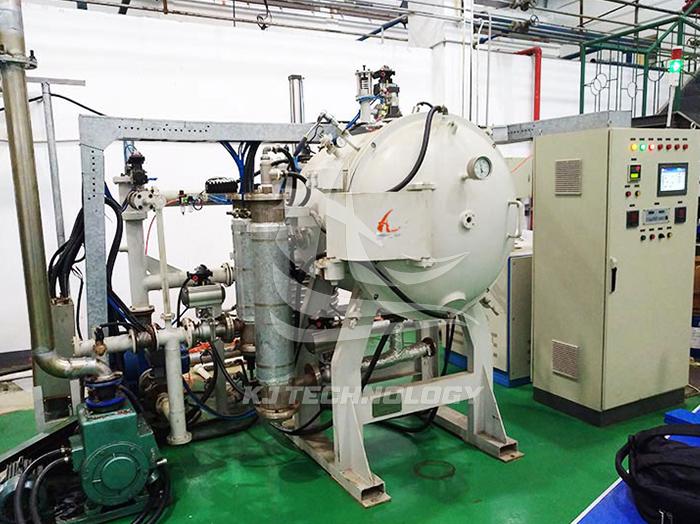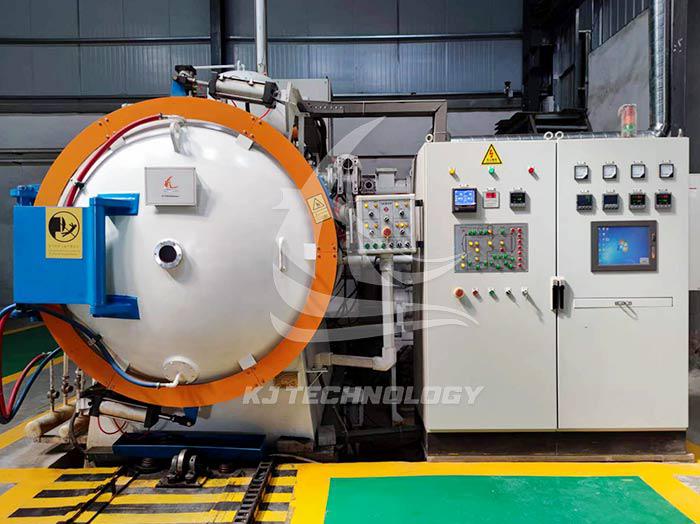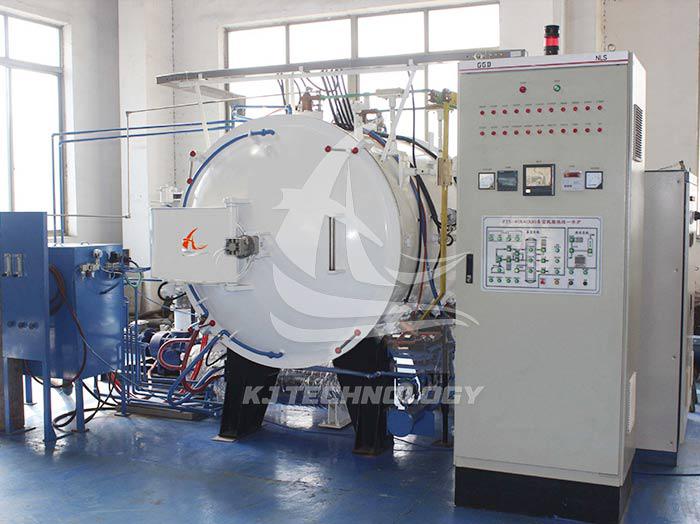What gases can be used in vacuum heat treatment atmosphere electric furnaces?
 06-30-2025 Author: KJ technology
06-30-2025 Author: KJ technology
The vacuum heat treatment atmosphere electric furnace can achieve process requirements such as material surface modification, degassing, protection, or reactive heat treatment by introducing different gases. According to their functions and application scenarios, gases can be mainly divided into four categories: protective gases, reactive gases, permeable gases, and reducing gases. The following is a detailed explanation of specific gas types and their applications:
1.Protective gas: prevents oxidation and decarbonization
Core function: Fill the vacuum furnace with inert gas, isolate oxygen, prevent material surface oxidation or decarburization, and serve as a cooling medium.
Argon gas (Ar)
Characteristics: Strong chemical inertness, does not react with any materials, high density (1.78 g/L), and high cooling efficiency.
Application scenarios:
High pressure gas quenching: pressure of 5-10 bar, cooling rate of 100-500 ℃/min, suitable for quenching high-speed steel and mold steel.
Titanium alloy treatment: prevents titanium from reacting with oxygen and nitrogen at high temperatures to form brittle phases (such as TiO ₂ TiN)。
Typical case: After high-pressure argon gas quenching, the hardness uniformity of aviation fasteners is ± 1 HRC, and the deformation is ≤ 0.05mm.
Nitrogen (N ₂)
Characteristics: Strong inertness, but may react with certain metals (such as titanium and chromium) to form nitrides at high temperatures.
Application scenarios:
Ordinary steel protection: used for annealing and normalizing carbon steel and alloy steel to prevent the formation of oxide scale.
Low pressure carburizing: As a carrier gas, it brings hydrocarbons such as methane and propane into the furnace.
Limitation: When the temperature is above 850 ℃, titanium alloy is prone to form TiN brittle layer, and the usage conditions need to be controlled.
Helium (He)
Features: High thermal conductivity (0.15 W/m · K), cooling efficiency three times that of argon gas, but high cost.
Application scenarios:
Ultra high speed cooling: used for gas quenching of thin-walled parts such as blades and thin sheet molds to reduce deformation.
Precision parts processing: such as quenching of optical glass molds, requires extremely low deformation (≤ 0.02mm).
Typical case: After helium quenching, the residual stress of a certain aviation blade decreased by 40% and the fatigue life increased by 25%.
2. Reactive gases: participate in surface modification
Core function: Reacts chemically with the surface of the material to form a compound layer or change the surface composition.
Hydrogen (H ₂)
Characteristics: Strong reducibility, capable of removing surface oxide films of materials, and participating in carburizing and nitriding reactions.
Application scenarios:
Degassing treatment: Hydrogen gas is introduced during the heating stage of the vacuum furnace to reduce TiO ₂ and Cr ₂ O3 on the surface of titanium alloy and stainless steel.
Low pressure carburizing: Hydrogen gas is used as a carrier gas to break down hydrocarbons into activated carbon atoms ([C]).
Safety risk: Hydrogen is flammable and explosive, and its concentration (<4%) and furnace pressure need to be strictly controlled.
Methane (CH ₄)
Characteristics: Cracking into [C] and H ₂ at high temperatures, it is the main carbon source for carburizing processes.
Application scenarios:
Vacuum carburizing: temperature 900-950 ℃, pressure 10-100 Pa, methane flow rate 0.5-2 L/min, carburizing layer depth 0.5-1.5mm.
Carbon nitrogen co diffusion: mixed with ammonia gas (NH3) to form a nitrogen-containing carbide layer.
Advantages: Compared to traditional gas carburizing, the uniformity of the vacuum carburizing layer is improved by 30%, and the carbon concentration gradient is smoother.
Ammonia gas (NH3)
Characteristics: It decomposes into [N] and H ₂ at high temperatures and is the main nitrogen source for nitriding processes.
Application scenarios:
Vacuum nitriding: temperature 500-600 ℃, pressure 10-50 Pa, ammonia flow rate 0.3-1 L/min, forming ε phase (Fe ₂ - ∝ N) and γ 'phase (Fe ₄ N).
Nitrocarburizing: Used in combination with methane or CO, with a surface hardness of HV 800-1000.
Effect: After vacuum nitriding, the wear resistance of mold steel is increased by 3 times and the corrosion resistance is increased by 5 times.
Carbon monoxide (CO)
Characteristics: At high temperatures, it decomposes into [C] and O ₂, but O ₂ is quickly evacuated by the vacuum system, and only [C] participates in the reaction.
Application scenarios:
Glow ion carburizing: As a carbon source gas, it is combined with a direct current electric field to achieve ion carburizing.
Low carbon steel carburizing: used for parts with low surface carbon concentration requirements (0.6% -0.8%).
Restriction: CO is toxic and requires exhaust gas treatment equipment.
3. Penetrating gas: achieving element diffusion
Core function: Provide active atoms (such as C, N, B) through gas decomposition, infiltrate the material surface to form a diffusion layer.
Acetylene (C ₂ H ₂)
Characteristics: Low cracking temperature (800-900 ℃), high carbon atom activity, fast carburizing rate.
Application scenarios:
Rapid carburizing: temperature 900 ℃, acetylene flow rate 0.2-0.5 L/min, carburizing layer depth 0.3-0.8mm/h.
Localized carburizing: Selective carburizing of gear tooth surfaces is achieved by directional injection of acetylene through a spray gun.
Advantage: The carburizing efficiency is 2-3 times that of methane, but the cracking temperature needs to be strictly controlled to avoid carbon deposition.
Melamine (C ∝ H ₆ N ₆)
Characteristics: It decomposes into [C], [N], and HCN at high temperatures, and can simultaneously achieve carbon nitrogen co diffusion.
Application scenarios:
Surface modification of mold steel: temperature 550-600 ℃, melamine flow rate 0.1-0.3 g/min, forming a nitrogen-containing carbide layer.
Pre treatment of tool coating: Enhance the adhesion between the coating and the substrate.
Effect: The hardness of the co infiltration layer reaches HV 1200, and the wear resistance is increased by 5 times.
Borane (B ₂ H ₆)
Characteristics: Highly toxic gas, requiring strict sealing, but high boronizing efficiency.
Application scenarios:
Vacuum boronizing: temperature 900-1000 ℃, borane flow rate 0.05-0.1 L/min, forming FeB/Fe ₂ B hard layer.
Wear resistant treatment: used for surface strengthening of rollers and molds, with a hardness of HV 1800-2200.
Safety measures: Equipped with gas leak detectors and emergency shut-off devices.
4. Reducing gas: Removing oxide layer and impurities
Core function: Remove surface oxide films or adsorbed gases (such as H, O) of materials through reduction reactions.
Hydrogen (H ₂)
Application scenarios:
Degassing treatment: The vacuum furnace is heated to 600-800 ℃, and hydrogen gas is introduced to reduce TiO ₂ on the surface of the titanium alloy (reaction: TiO ₂+2H ₂ → Ti+2H ₂ O).
Pre brazing treatment: Remove the oxide film on the surface of aluminum alloy and copper alloy to improve the wettability of the brazing material.
Effect: After hydrogen reduction, the surface roughness Ra of titanium alloy decreased from 1.5 μ m to 0.5 μ m.
Methanol (CH ∝ OH)
Characteristics: Cracking into [C], [H], and CO, with both carburizing and reducing functions.
Application scenarios:
Replacement of protective atmosphere furnace: Introduce a mixture of methanol and nitrogen gas into the vacuum furnace to simulate a traditional protective atmosphere.
Bright annealing of low carbon steel: prevents the formation of oxide scale, while performing slight carburizing (surface carbon content 0.1% -0.2%).
Advantages: Lower cost than pure hydrogen and higher safety.
Carbon monoxide (CO)+hydrogen (H ₂) mixture
Characteristics: CO provides reducibility, H ₂ promotes cracking reaction.
Application scenarios:
Stainless steel bright annealing: temperature 1050-1100 ℃, CO: H ₂=1:1, to prevent chromium oxidation (reduction of Cr ₂ O3 to Cr).
Repair of decarburization layer in high-temperature alloys: reduce surface oxide layer and restore material properties.
Effect: After mixed gas annealing, the surface smoothness of stainless steel reaches Ra 0.2 μ m, and the corrosion resistance is doubled.
5. Special gases: functionalized treatment
Neon (Ne), Krypton (Kr), Xenon (Xe)
Application scenarios:
Ultra high speed cooling: Xenon gas has a higher thermal conductivity than argon gas and is used for gas quenching of extremely thin parts (thickness<0.5mm).
Research experiment: Study the influence of gas types on the phase transition kinetics of materials.
Limitations: Extremely high cost, only suitable for special scenarios.
Carbon dioxide (CO ₂)
Application scenarios:
Active screen plasma nitriding: As a reaction gas, [N] and [O] are generated through plasma cracking.
Low carbon steel surface oxidation: used for processes that require controlling the thickness of the oxide layer (such as bluing treatment).
Effect: The hardness of the CO ₂ plasma nitriding layer reaches HV 600-800, and its wear resistance is better than traditional nitriding.
6. Gas selection principle
Material compatibility:
Titanium alloy: Avoid using nitrogen gas (>850 ℃ to generate TiN), and prioritize argon or hydrogen gas.
Stainless steel: Nitrogen or CO+H ₂ mixture can be used to prevent chromium oxidation.
Process requirements:
Carbonization: methane, acetylene CO。
Nitriding: Ammonia gas, CO ₂ (plasma nitriding).
Degassing: hydrogen, methanol.
Security:
Hydrogen and borane require explosion-proof devices.
CO、 Methanol requires tail gas treatment.
Cost effectiveness:
Argon gas has a moderate cost, while helium gas is only used in high-end scenarios.
Methane and ammonia have higher cost-effectiveness than acetylene and melamine.








